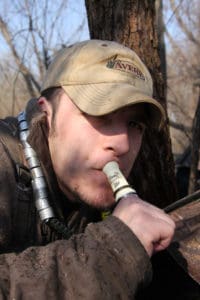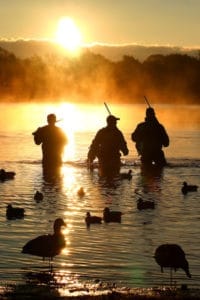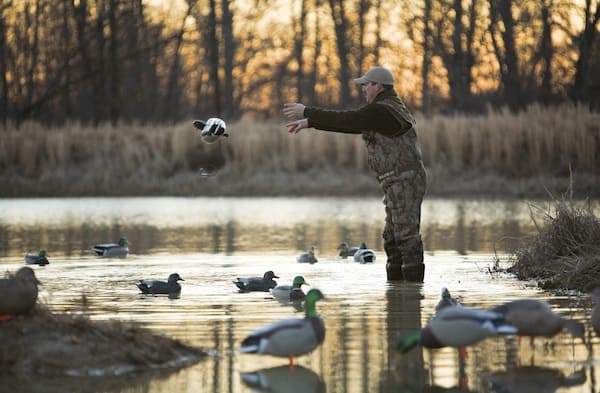by M.D. Johnson
For many duck hunters, the late Alfred Hitchcock could not have penned a more fitting work of horror than that which could be set at any of the nation’s more popular public waterfowling locations. Many of you, I’m sure, have either experienced, or at the very least, heard tell the tales. Boats crammed gunwale to gunwale; hunters in such close contact, they should be sharing coffee. Nocturnal drag races from the launch.
Avian maestros, thinking themselves skilled at duck speak, who insist on screaming through their pieces of wood and acrylic at every bird, duck or otherwise, that happens to enter their airspace. And then there are the long-range enthusiasts; individuals who operate their ‘fowling arms with the mantra, “If I can see it, I can shoot it at.” Some would call it a circus; to others, it’s Hell Incarnate. For many, though, these scenarios are just another day on the WMA – and that’s wildlife management area, just in case you didn’t know.
But does public waterfowling have to be this way? No more, I don’t believe, than any other function in which the general public might be involved. Those partaking of these public opportunities, however, should take to heart 10 simple rules designed to minimize the aggravation while maximizing the overall enjoyment of the experience. So follow along, and for some, it might not be a bad idea to print these out and carry them in your blind bag, just in case.
I – Thou shalt remember a shotgun is a short-range weapon
Unless your name is Tom Roster, shooting at ducks 80 yards away is a waste of ammunition, at best. At worst, it’s a tremendous irritation to the man 300 yards away. A shotgun is, and always has been, a short-range weapon. Those 100-yard Poke ’n Hopes at every passing mallard aren’t going to be effective, unless, that is, the goal is to make a neighbor angry. In that regard, long-range shooters might be successful.
II – Thou shalt not crowd nor interfere with the hunts of others
If you’re going to set up 75 yards away from an already established and in-use spread, you may as well ask that other man if you can shoot out of his blind. How much space is enough between you and the next guy? Common sense comes into play here. If it’s too tight and you weren’t there first, go somewhere else.
III – Thou shalt not shoot another man’s swing
You’ve allowed yourself 300 yards from the next group; however, you’re downwind, and positioned as such, you’re tempted to shoot into every flock making their approach to your neighbor’s spread. Just how long do you think it will be after you bust the third bunch swinging before you get The Visit? Here, it’s common courtesy. Work your own birds, share, or a little of both. Trust me; The Visit usually isn’t friendly.
IV – Thou shalt know and adhere to waterfowl regulations
Ignorance is no excuse when the man in green is standing at the door of the blind asking about that third canvasback hanging from your strap and then explaining how the limit is two. On public wetlands, perhaps the most commonly ignored regulation concerns legal shooting times, both opening and closing. It’s best you know when to start and stop, or someone’s going to inform you.
V – Thou shalt not blow thine duck call in a never-ending manner
We’ve all heard him – the man with the monster lungs. This guy starts blowing into his duck call when he gets into the blind, and doesn’t stop until the owls hoot. Mallards, wood ducks, pintails, show tunes; this guy knows it all, and isn’t afraid to demonstrate his audio prowess in a mind-numbingly nonstop manner. Duck calls are, without question, effective tools when used correctly, but really? Eight straight hours?

With duck hunting, over-calling is a common mistake, and it’s particularly a negative on crowded public land.
VI – Thou shalt not dawdle nor linger at set-up or teardown
If you’re going in well after legal shooting time, the rules are simple. Get in, get set, and get hidden. Don’t cruise around endlessly in search of THE spot, and once there, take 60 minutes to throw out 10 decoys while screaming at the dog and revving the mud motor to the redline. Be efficient, and be polite.
VII – Thou shalt not leave ‘fowl carcasses at the ramp nor parking lot
Not everyone who visits the boat ramp at a public hunting area is a hunter. And as such, a pile of breasted birds haphazardly discarded off the edge of the gravel, yet still in plain view, could very possibly transform that middle-aged non-hunting birder into a budding anti-everything. I don’t want to see that either. Nor do I want to see Styrofoam cups, Walmart bags, cigarette packs or Little Debbie wrappers. It’s all garbage; take it home.
VIII – Thou shalt not be ill-tempered with thy fellow ‘fowler
Unfortunately, there may come a time when a confrontation with an individual afield cannot be avoided. Perhaps they’re at fault. Or maybe it’s you they believe isn’t acting accordingly. Either way, it’s generally unwise to confront a complete stranger whom you know to be (1) armed and (2) highly agitated. No duck is worth it. If it’s you who’s getting tight, step back, and relax. If you’re the target of another’s wrath, ignore it best you can. Failing that, a phone call to the local conservation officer might not be a bad idea.
IX – Thou shalt work harder than thine neighbor
When it comes to public waterfowling areas, working harder pays off. Get up earlier, stay later, set a different spread, call more realistically, hide better. Success here isn’t easy, but the secret isn’t nuclear physics, either.
X – Thou shalt not lose sight of ‘fowling’s recreational aspect
Never forget waterfowling is supposed to be enjoyable. Anything involving firearms is a serious matter; however, it’s possible to take entertainment, i.e. the quest for fun, too seriously, and in doing so, lose sight of the true reasons we’re afield. Besides, if I want to raise my blood pressure and foster the urge to beat something, I’ll sit and pay bills.
The Union Sportsmen’s Alliance website is designed to provide valuable articles about hunting, fishing and conservation for members of AFL-CIO affiliated labor unions and all sportsmen and sportswomen who appreciate hunting and fishing and want to preserve our outdoor heritage for future generations. If you would like your own story and experience from the outdoors to be considered for our website, please email us at [email protected].





